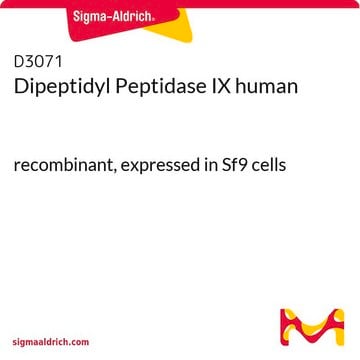Kluczowe dokumenty
D3446
Dipeptidyl Peptidase IV human
recombinant, expressed in Sf9 cells
Synonim(y):
CD26, DPPIV, Dipeptidyl aminopeptidase IV, Glycoprotein GP110
Wybierz wielkość
3340,00 zł
Wybierz wielkość
About This Item
3340,00 zł
Polecane produkty
rekombinowane
expressed in Sf9 cells
Poziom jakości
Formularz
solution
aktywność właściwa
≥4,000 units/μg protein
masa cząsteczkowa
124 kDa
stężenie
≥0.01 mg/mL
numer dostępu UniProt
powiązane choroby
cancer (lymphoma, prostate and colon cancer)
Warunki transportu
dry ice
temp. przechowywania
−70°C
informacje o genach
human ... DPP4(1803)
Szukasz podobnych produktów? Odwiedź Przewodnik dotyczący porównywania produktów
Powiązane kategorie
Opis ogólny
Zastosowanie
Działania biochem./fizjol.
Definicja jednostki
Postać fizyczna
Inne uwagi
Hasło ostrzegawcze
Danger
Zwroty wskazujące rodzaj zagrożenia
Zwroty wskazujące środki ostrożności
Klasyfikacja zagrożeń
Eye Irrit. 2 - Repr. 1B - Skin Irrit. 2
Kod klasy składowania
6.1D - Non-combustible acute toxic Cat.3 / toxic hazardous materials or hazardous materials causing chronic effects
Klasa zagrożenia wodnego (WGK)
WGK 1
Temperatura zapłonu (°F)
Not applicable
Temperatura zapłonu (°C)
Not applicable
Wykazy regulacyjne
Wykazy regulacyjne dotyczą głównie produktów chemicznych. Można w nich podawać ograniczoną liczbę informacji na temat produktów niechemicznych. Brak wpisu oznacza, że żaden ze składników nie znajduje się w wykazie. Użytkownik odpowiada za zagwarantowanie bezpiecznego i zgodnego z prawem stosowania produktu.
EU REACH Annex XVII (Restriction List)
Wybierz jedną z najnowszych wersji:
Certyfikaty analizy (CoA)
Nie widzisz odpowiedniej wersji?
Jeśli potrzebujesz konkretnej wersji, możesz wyszukać konkretny certyfikat według numeru partii lub serii.
Masz już ten produkt?
Dokumenty związane z niedawno zakupionymi produktami zostały zamieszczone w Bibliotece dokumentów.
Klienci oglądali również te produkty
Active Filters
Nasz zespół naukowców ma doświadczenie we wszystkich obszarach badań, w tym w naukach przyrodniczych, materiałoznawstwie, syntezie chemicznej, chromatografii, analityce i wielu innych dziedzinach.
Skontaktuj się z zespołem ds. pomocy technicznej











